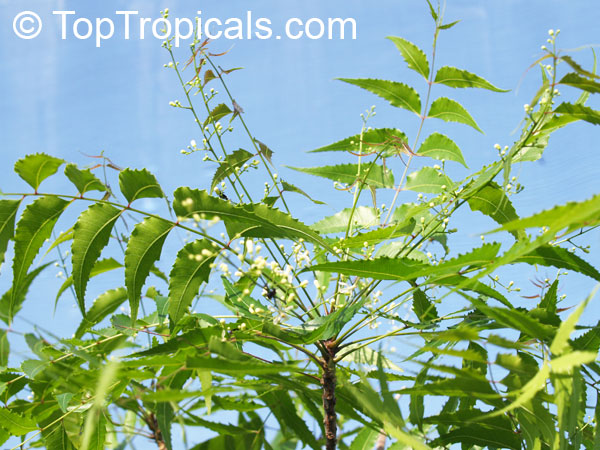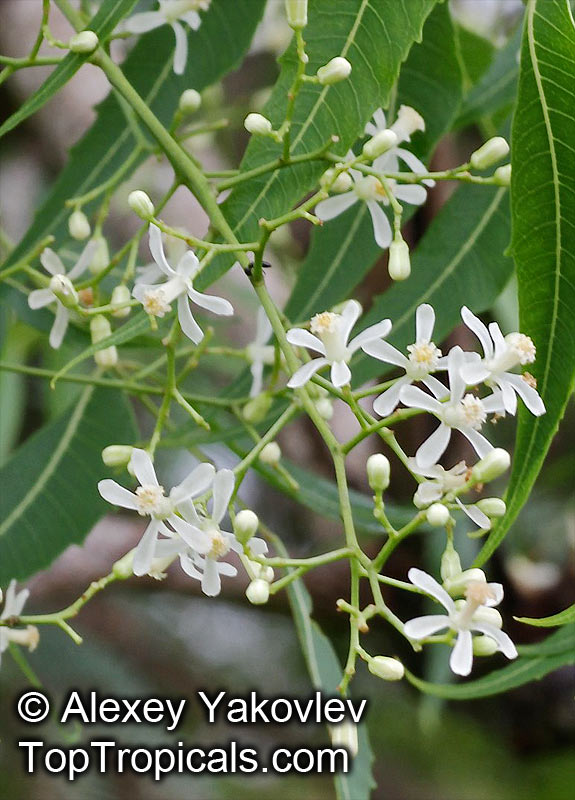NEEM - The Free Tree of India
by Onika Amell
About the Author
Onika Amell was born in farmer's family in Cape Town, South Africa, and always had a keen interest in gardening. She has been a globe-trotter for many years, traveling along with her husband, an engineer, and her life is worth a novel. In Cape Town she worked in groups “Soil for Life and Work for Love”, teaching people how to grow their own food, improve their health, and protect the environment. Onika lived in Galilee, Israel, skydiving over 500 jumps and working on the fields planting, harvesting and caring for various crops (Lychee, Avocado, Bananas, etc), helping out in community gardens... In SE Asia, she taught English at business centers... Upon finally settling in SW Florida, she joined the ECHO Global Farms project on teaching farmers/families around the world about effective crop production... Now as a part of Top Tropicals Team, Onika is our plant expert and a columnist. Onika's biggest passions are plants and... of course – cats, who are her children! She has six of them: Itembi, Freddie Mercury, Donald Trump (he is the difficult one), Tigerlilly, Sweetie, and Jaxson.
Q: What is Neem oil and tree, and and can we grow the Neem tree here in the US?
A: Neem! What an extraordinary, fascinating tree! I'm personally convinced every garden should have one, if your climate allows it.
Cultivation
Neem tree - Azadirachta indica - will very quickly become a valuable shade tree in your garden. They can grow up to eight feet per year! Neem trees are also known to grow very well in areas with infertile soil and under very dry conditions, which makes them perfect for in a xeriscaping. Not only is Neem fast growing, but it's a beautiful tree with wide spreading branches and dark green leaves. It will form a dense, round canopy, up to 60 ft wide. Under optimal conditions it can hug the sky at 100 feet but it typically only grows to around 30-40 feet in height. This tree certainly has longevity also. It can live up to 150+ years! Only the warmest areas of Florida, Texas, Arizona and California (Zones 9-10) are warm enough to grow Neem in the ground. This tree loves rich, moist (but not wet) soil and full sun. It will not tolerate cold temperatures or saturated soils, nor water-logged areas and poorly drained soils.
Having said that, gardeners in colder areas can easily grow this tree in a large pot as very beautiful houseplants that spend summers outside and winters indoors! For best results, a good quality, well-draining potting soil should be used. The tree should be planted in a three-gallon pot for its first year, thereafter the size of the pot should be gradually increase until it's as large as you can comfortably handle. Neem should never be exposed to freezaing temperatures until the tree is well established and can take a few hours of cold chill. Warm, even hot, temperatures are very important to successfully grow this tree. When temperatures drop to below freezing, the tree needs to be taken inside.
Usage
This wonderful tree has been used by humans for thousands of years. Did you know Neem has more than 100 unique bio-active compounds? Surprisingly, a lot of gardeners are still unfamiliar with it. Neem is native to India. More than 20 million Neem trees live there. To this very day, rural Indians consider Neem as the village pharmacy. It is considered a holy tree. No surprise then that the botanical name of Neem is Azadirachta indica, which translates to "The Free Tree of India", because of its many uses and benefits in a garden.
The list of beneficial products used by people from the Neem tree is simply astonishing! Let's take a look at just a few:
Medicinal
Various parts of the tree have anti-malarial, antiseptic, antibacterial, antifungal, anti-parasitic, anti-inflammatory and anti-ulcer properties.
Neem really shines in skin care and the treatment of skin disorders. It is used to condition hair, skin and nails and can even lighten scars and pigmentation. Got dandruff? Take some Neem oil and rub it into your scalp, leave it in for a while and wash. Goodbye dandruff. Neem oil will also strengthen your hair and prevent hair loss.
Each day in India, millions of people break-off a Neem twig and use it as a toothbrush. The compounds in the Neem bark have strong antiseptic properties and prevent tooth decay as well as preventing and healing inflammation in gums. There are a large number of companies nowadays offering Neem toothpastes and mouthwashes.
Neem extract are used by millions of impoverished people as a low-cost, natural pain relief. Its surprisingly effective as an analgesic and as an antipyretic or fever-reducer.
New research indicates that Neem is also very effective as an immune-booster, a liver-protector, a possible diabetes treatment and a rich source of antioxidants when used as a dietary supplement. It is being tested in anti-aging compounds and treatments for dry, itchy skin. In fact, Western researchers are just beginning to scratch the surface to discover what others have known for thousands of years.
A warning: Neem is a very powerful herb. Always seek the advice and guidance of a qualified herbalist or medical doctor before experimenting with it. This golden rule applies for all plants.
Insecticide/repellent
It can even be used as a natural insect repellent! Neem seed oil is mostly known and valued as a safe and effective insecticide. It works against insects by repelling them, preventing their feeding and essentially starving them. Lots of nurseries stock Neem oil these days for this very purpose. It is especially popular among organic gardeners.
Improving soil
You can use all parts of Neem as a mulch, a compost ingredient or as a soil amendment in your garden. In fact, Neem is often used to improve very poor soil. It has the amazing ability to bring acid soils back to neutral. The deep tap root breaks through hard layers, mine the subsoil for nutrients and bring them to the surface. The root system is also great for anchoring loose soils. When Neem residue is sprinkled on top of soil, it is taken up by plant roots and used as a plant defense mechanism, for up to 10 weeks, against insect infestations. Furthermore, pollinators like bees, moths and bats as well as beneficial insects such as spiders, ladybugs and dragonflies, are never harmed from Neem extracts. Nor any known warm-blooded animals or birds.
Wood
Even the wood of this tree is valuable. It is used for building homes, boats, docks etc.
The Neem oil also makes an effective industrial lubricant and lamp oil.
Should we grow it? Absolutely! Neem is intriguing and rewarding. Even if you are not into lotions and potions, planting a Neem tree (or two) in your garden will quickly give you a beautiful shade tree with instant bragging rights. What a wonderful conversation piece to have! Neem is a reminder, at the very least, of how fascinating and powerful nature is. And for those of you who appreciate a little fragrance in the garden? Neem produces huge clusters of flowers that are made up of up to 250 individual white blooms that has a sweet, almost mystical jasmine like fragrance at night. They blossom once in the afternoon and then again in the evening.¦ Twice the delight!
What are you waiting for?



